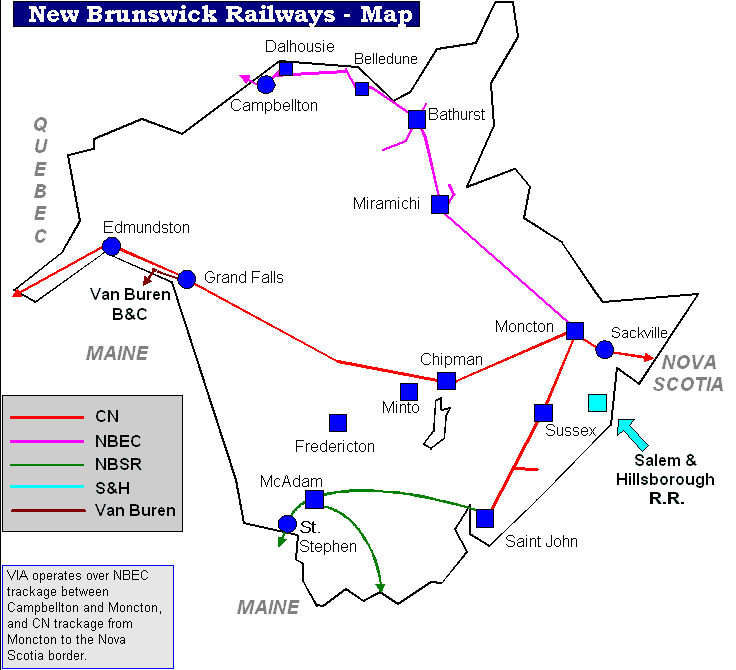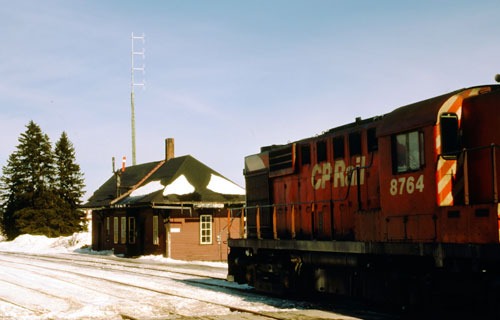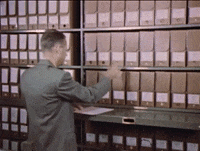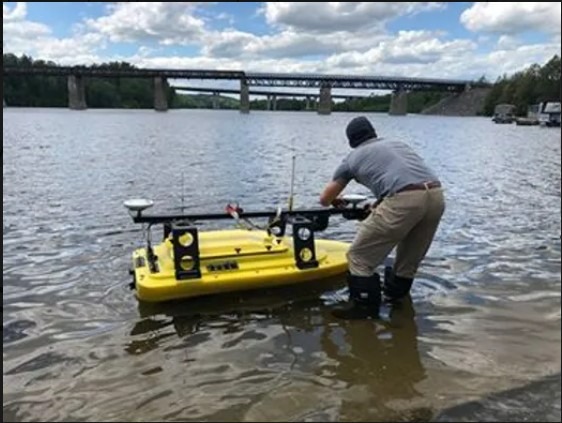
Locomotive 508 Mystery / The Marina

The first railroad in Grand Falls was a half-mile long line made of narrow-gauge rails. It started from Sir John Caldwell's mill, near the falls, and went up to a spot just above the lower basin. Of course, this was in the 1800s and the carts were pulled by horses.
You will find a description of the latter in Peter Fisher's Noticia of New Brunswick, published in 1838. It was quite a novelty at the time since the province didn't have a railway at all yet.
source : Grand Falls Yesterdays - Margaret Marceau
One of the first major railways to cross the territory of New Brunswick was the Intercolonial Railway of Canada from Nova Scotia to Lévis, inaugurated in 1876. The route chosen by Canadian rail engineer, Sandford Fleming, went through Moncton, Newcastle, Dalhousie, Cambelton, and crossed over to the Gaspé Peninsula. The Intercolonial connected the Maritimes to the other provinces of the new Canadian Confederation.
source : https://archives.gnb.ca

On October 11, 1877 - (Le Moniteur Acadien) Grand Falls, construction of the station.
The construction of the railway station in Grand Falls has begun. The building will be 130 feet by 35 feet in size.

The Canadian Pacific Railway today...
Today, the Canadian Pacific Railway has been transformed into a cycling trail that is used by residents for walking, running or cycling.
A committee is currently working to revitalize the trail by paving it with asphalt.
The mystery of Locomotive 508

The collapse of this bridge was undoubtedly the most spectacular event that happened on Thursday, June 21, 1900. It collapsed as a train from Edmundston was crossing it. The convoy crashed into water that was 20 feet deep. The locomotive was number 508 of the Canadian Pacific Railway. It consisted of 7 freight car, a first-class car, and a combined baggage car.
There were no fatalities, although the passenger agent and the locomotive driver were seriously injured. There were also six passengers on board at the time of the accident. They all managed to escape with minor scratches.
On Friday evening at around 10 o'clock, a Canadian Pacific Railway team left Saint John on board a locomotive via the Intercolonial Railway to Rivière-du-Loup and then took the Témiscouata Railway to Edmundston before finally taking the CPR railway to the site of the accident.
The locomotive assisted in the transfer of passengers and goods from the river side towards Edmundston and helped life the debris. However, it is unclear whether the locomotive 508 was recovered from the river.
source : Grand Falls Yesterdays - Margaret Marceau
What happened to Canadian Pacific Railway locomotive 508?


Although the missing locomotive does not leave most residents of Grand Falls perplexed, it does for Eric Ouellette, an engineer residing in Grand Falls.
As an engineering student at the University of Moncton, he first learned about the collapse of the trestles bridge near his hometown over 100 years ago. What intrigued him about the incident were the rumors that locomotive 508 was never found. This didn't fit his engineering mind.
How can a 35-ton steam locomotive simply disappear?


One century later, the search begins!!!
In 2003, the search for locomotive 508 began.
The nearby road bridge needed to be rebuilt, which triggered the search. The plan was to try to find the engine before the crane and barge finished working on the Ministry of Transportation structure just a few hundred meters away.
Despite many search efforts, the mystery of the missing locomotive 508 remains unsolved. Over the years, various stories and opinions have emerged about its fate, but no one has come forward with information that would definitively solve the mystery. Some believed that it was salvaged, while others argue that it was not. There have even been reports that the locomotive was recovered by residents many years later and dismantled for scrap metal.
So according to an email response from the CP railway, when Ouellette made his initial inquiries about the 508, he was told the following : "The CP railway had to retrieve the locomotive from the river, as it continued to serve us until it was disposed of (likely scrapped) in February 1910. However, this was after it had been modified and renumbered as locomotive no. 62 of the CP railway in November 1908. We have locomotive assignments for July 31, 1904. Locomotive no. 508 was assigned to and serviced in Edmundston, New Brunswick."
It goes without saying that "had to" did not dispel the mystery, so further investigative work was done by searching different archives and talking to local people about the accident. The archives gathered many interesting stories about the accident, but even they proved to present many divergences, mainly regarding the names, measurements, and the span of the bridges that actually collapsed.
It is true that very few locals were aware of the accident because it happened over a century ago, but for those who remembered, none of them could say for certain whether the locomotive had been recovered or not. The information gathered was primarily secondhand accounts from relatives who recounted the accident many years later, as well as all the drama that followed.
After a few months of interviews and research, it became clear that the mystery wasn't going to be solved just by talking. Eric managed to convince a team of volunteers and divers to go in search of it. The best way to solve the mystery was to literally go to the bottom of the river, find the location of the accident, and perhaps even locate the locomotive.
2003
The search efforts proved to be more difficult that expected due to poor visibility. The search area was significantly narrowed down with the help of the University of New Brunswick, which offered to conduct a detailed magnetic survey of the river in the accident area.
The investigation revealed very interesting magnetic anomalies that were located directly between two piers of the old bridge. The divers focused on these magnetic areas, but were unable to locate the locomotive before the departure of the crane and barge nearby.
A few very interesting pieces were found during one of the dives in the magnetic debris field. East Dive of Fredericton, New Brunswick, was able to recover what was later identified as part of the braking system and possibly even from the locomotive itself.



Ouellette never gave up that summer and, with the brake components in hand as encouragement, he pursued another avenue of scientific exploration. Nick Burchill of Kongsberg Maritime in Dartmouth, Nova Scotia, agreed to donate his time and equipment and conduct a detailed sonar survey above the magnetic debris field. The survey was conducted on ice and for this reason, it was actually very easy to locate the area of interest.

Once again, very interesting results showed the two underwater bridge piers with a long object directly between them. The long object was confirmed by divers as a large sand mound. The divers also reported that this was a bit strange given that the rest of the riverbed floor was mostly gravelly. Two of the recovered brake pieces were lying on the ground next to the sand mound and the extrusion of the mound was the third piece. The 3 pieces were found very close to each other, but the 3rd piece broke off from a much larger buried piece. The divers dug into the mound and try to see if the larger buried piece could be removed, but it was too large to be pulled out with the boat. Ouellette applied for all necessary permits to dig into the sand mound in 2006, but the opportunity to dig into the riverbed never materialized mainly due to Ouellette's busy work schedule.
June 25, 2020
We had a very productive day collecting data at the wreck site of 508. Brunswick Engineering kept their promise to come and try to solve the 120 year old mystery, not to mention my 20 year obsession to get to the bottom of things. Today, a drone magnetic scan of the river was performed. We also explored further with a remotely operated multi-beam survey vessel. In addition to all of this, we also executed a side-scan sonar on the site, so there is a lot of exciting data to review.
The alignment of the old bridge was concentrated, and we covered the entire width of the river just to make sure we covered everything. These cutting-edge instruments will allow us to map the riverbed with great precision. The 2003 magnetic survey can now be used to estimate the weight of iron resting on the bottom and further pinpoint the area of metal debris.
After a successful day of data acquisition, the team of engineers and scientists left and returned home before nightfall. It will take several weeks to analyze all of this data, but stay tuned for the results. We have never visited the site with as much science as today.
Volunteers:
Andrew Black - Brunswick Ingénierie
Caleb Parker - Brunswick Ingénierie
Karl Butler - UNB
Troy Dobson - UNB
Daniel Boulay - UNB
Marc Laforge - Gemtec / boat captain
Steve Perry - Brunswick Engineering
Eric M. Ouellette, P.Eng. President Zip Zag Canada
In July 2020, Eric was very excited to think that they had just solved the mystery.
With all the information below, he had never been more convinced that the engine still rests at the bottom of the St. John River and was never recovered years ago.
-They now had a very precise 3D map of the riverbed.
-They could now clearly see the old underwater bridge piers and the icebreaker piers.
-They could also clearly see a huge mound resting directly where the bridge collapsed.
-Now they could ride the iron anomaly on this map, which is located in the same area as the mound.
-They had even been able to confirm that there are two main metallic objects that appear. The first is likely an old rail that was seen during the 2003-2004 dives. The second is a much larger piece and is estimated to be 8 to 10 tons!!!!
It is possible that the locomotive 508 was heavier than that, but keep in mind that the accident likely damaged the engine, and it is probably no longer intact (probably also why they left it there). It is also interesting to note that the brake parts they had found in 2003 came from this mound. Divers had reporter the sand mound between the pillars, but they didn't understand why the normal riverbed was exposed to rocks and gravel, yet the mound was mainly composed of sand. When they had retrieved those three pieces in 2003, one of them broke off from a much larger piece and they were not able to recover it, mainly because it was buried in the sand. They didn't realize that they were pulling on the engine itself. It was later confirmed that the pieces from 2003 were from the locomotive's braking system.
It is the task that Eric has undertaken to do. "Solving the mystery was the main goal so far, but will there be any interest in recovering the remains of the engine?"
"This question could be the subject of another interview in the future, depending on the interest in doing so or not. Nevertheless, it would be very cool to reunite the engine with the still-standing CP station nearby. The locomotive 508 never arrived at its destination on June 21st, 1900, but it would be an interesting attraction to visit if we ever reunite them someday."
Eric Ouellette, P.Eng President of Zip Zag Canada
Closing notes :
Research has come a long way since 2000 and the locomotive 508 had been read and heard by many people around the world.
Eric tried to solve the mystery for years and did it at his own pace over the years. So far, the research has not cost anything and everyone who participated did so voluntarily.
Source :
Toronto Star Newspaper
https://www.508mystery.com/